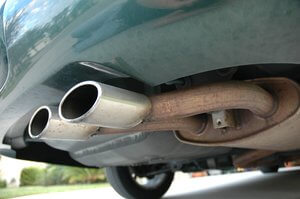
JB Tools and Eric the Car Guy have joined forces to create a complete destination for automotive enthusiasts. Visitors of JB Tools have always had the opportunity to purchase hundreds of brands of automotive tools & equipment at rock bottom prices. And now we are offering a complete library of auto repair help, auto repair troubleshooting guides, how to articles, auto repair tips and much more. The best part is that Eric the Car Guy offers his expansive library of free informational articles and videos to anybody with an internet connection! Browse the categories below and be directed to one of the most complete automotive repair websites on the internet, or check out Eric the Car Guys YouTube channel where hundreds of auto repair videos are available.
Eric the Car Guy's YouTube Channel
-
Engine Overheat

If your engine overheats, the temperature gauge will read higher than normal and steam may even occur. There are many reasons why and how your engine can overheat. And it is important to diagnose and fix it as soon as possible as an overheated engine can be dangerous and will effect how the engine runs overall.
-
No Start

When your automobile isn’t starting, it’s vital to figure out what type of no-start issue you are experiencing. There are two main types: no crank/no start and crank/no start, depending on if the engine cranks.
-
Electrical

Electrical issues are of the more difficult issues to address. In order to understand electrical issues, you should have a basic understanding of electricity and how it works in the automotive systems first.
- Basic Automotive Electricity
- Voltage, Amps, Resistance, and Ohm’s Law
- Voltage
- Voltage Drop Testing
- Amperes
- Ampere Testing
- Resistance
- Testing Resistance
- Electricity and Magnetism
- Solving Automotive Electrical Problems
- Come up with a Plan
- Check the Battery
- Check the Fuses
- Find a Wiring Diagram
- Relays
- Parasitic Draw Testing
- Closing
-
Performace & Drivability

Since this is a broad topic that covers a wide variety of issues, understanding the basics of identifying performance issues is the best way to get started.
- Identify the Problem
- The Basics
- Pulling Codes
- Pulling Codes, Pre OBDII
- After You Get the Codes
- Performance Diagnosis, No Codes
- Power Braking Test or Stall Speed Test
- Diagnosing Engine Problems
- Power Balance Testing
- Check for Vacuum Leaks
- Voltage Leaks
- Notes on Honda Ignition Systems and Aftermarket Parts
- Aftermarket Parts
- Fuel Delivery Problems
- Fuel Pressure Regulators
- Hard Starting Problems
- Fuel Injector Issues
- The Fuel Filter
- Replacing Honda Fuel Pumps
- Mechanical Issues
- Engine Timing
- Ignition Timing
- Compression Testing
- Leak Down Testing
- Using a Vacuum Gauge to Check Engine Performance
- Using a Vacuum Gauge to Find Exhaust Restrictions
- Catalytic Converter Problems
- Exhaust Leaks
- Don't Forget the Basics
-
Noises

Noises often indicate an issue with your vehicle—and the possible problems are varied. Being able to isolate where the noise is coming from is the most important first step.
- Finding Noises Video
- Engine Noises
- Using the Correct Oil Viscosity/Using Synthetic Oils
- Loose Torque Converter Bolts and Cracked Flex Plates
- Thrust Bearing Issues
- “Ticking” Engine Noise
- Other Engine Compartment Noises
- Automatic Transmission Noises
- Thumping Noise When Changing Gears
- Buzzing or Whining Noises, Automatic Transmissions
- Manual Transmission Noises (General)
- Clutch Noises
- Manual Transmission Noises
- Driveline Noises
- Transfer Case Noises
- Differential Noises
- Axle Noises (RWD)
- CV Joints and FWD Axles
- Suspension Noises
- Struts, Shocks, and Dampers
- Finding Suspension Noises
- Wheel Bearing Noises
- Tire Noises
- Exhaust Noises
- Rattles
- Other Noises
-
Brakes

Brake repairs tend to be one of the most popular automotive DIY repairs. Intimidating at first, brake repairs get easier with practice. This section will contain helpful guides and tips on how to repair your own brakes.
- Disc Brakes
- Brake Noise
- Types of Friction Material
- Brake Vibrations,Warped Rotors or Drums
- Machining Brake Rotors and Brake Drums
- On-the-Car Brake Lathe
- Torqueing Wheels and Why It's Important
- Disc Brake Service
- Servicing Rear Disc Brakes
- How to Diagnose a Bad Brake Caliper
- Rebuilding Brake Calipers
- Replacing Rear Calipers
- Removing Rotor Screws
- Servicing Drum Brakes
- Removing Brake Drums
- Tapered Roller Bearings
- Replacing Brake Shoes
- Replacing a Wheel Cylinder
- Parking Brake Issues
- Master Cylinder Problems
- Finding Brake Fluid Leaks
- Brake Booster Problems
- Hydroboost Systems
- Bleeding the Brake System
- Changing Brake Fluid
- Flaring Brake Lines
- Brake Hose Problems
- Dealing With a Spongy Brake Pedal
- ABS/TCS
- Removing Wheels That Won't Come Off
- Removing Wheel Locks Without a Key
- Drum Brake to Disc Brake Conversions
-
Idle Issues

Idle issues can be caused by a number of issues and is a seemingly common problem. In some ways, engine idle is a measure of how good or bad your engine’s health is.
-
Transmissions

Whether you have a manual or automatic transmission, they both provide a reverse gear and mechanical advantage to the engine’s power outlet. The transmission works to keep the engine in a good operating range for maximum power and efficiency.
- Manual Transmissions
- Clutches
- Diagnosing Clutch Problems
- Clutch Adjustments
- Hydraulically Operated Clutches
- Hydraulic Clutch Problems
- Solving Manual Transmission Problems
- Internal Manual Transmission Problems
- Honda Manual Transmission Tips
- Automatic Transmissions
- Diagnosing Automatic Transmission Problems, Preliminary Checks
- Checking Fluid Level and Condition
- Notes on Honda Automatic Transmissions
- Checking for Automatic Transmission Codes
- Checking Vacuum Modulators
- Checking Throttle Cables
- Torque Converter Problems
- If I Don't Change My Automatic Transmission Fluid for a Long Time, Will the Transmission Fail When I Do?
- Servicing Automatic Transmissions
- In Summary
-
HVAC

HVAC stands for Heating, Ventilation and Air Conditioning and these HVAC systems can be found behind your dash for the most part. Most work will be split into heating and on AC.
- Working on Your Vehicle’s AC System
- AC System Basics
- AC Performance Testing
- Finding Out What's Wrong With Your AC
- Finding AC Leaks
- Repairing AC Leaks
- Mixing Refrigerants
- Recharging AC Systems
- Think About Replacing the Receiver Dryer or Accumulator
- Adding Oil to the AC System
- Retrofitting AC Systems
- Rear AC Systems
- Evaporator Odor
- Stop-Leak in Your AC System
- Black Death
- Flushing the AC System
- Water or Swishing Noise in Your Dash
- Heater Problems
- Thermostat Problems
- Clogged Heater Core
- Heater Control Valves
- HVAC Controls and Air Flow in the System
- Blower Motor Problems
- Cabin Air Filters
- Defogging Windows
- Summary
-
Vibrations

There is a range of different vibrations that you may feel when you are driving your vehicle. This section will over the basics on different vibrations, their causes and how to consequently fix these issues.
-
Tips for Buying a Used Car

In the market for a used car? Check out this video series that will answer every question you have, and even answer the ones you didn’t know to ask, about buying a used vehicle.
Industrial automation robotic & electronic repair, sales and service


